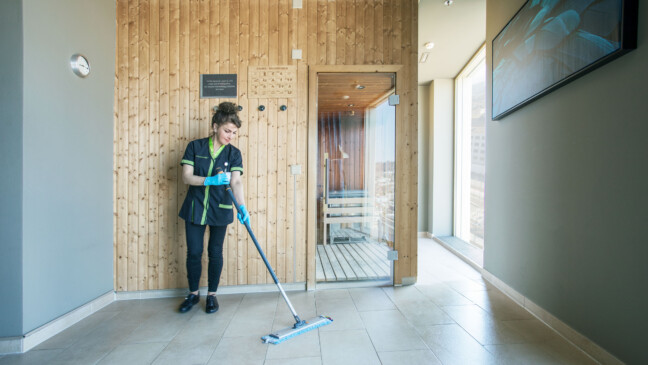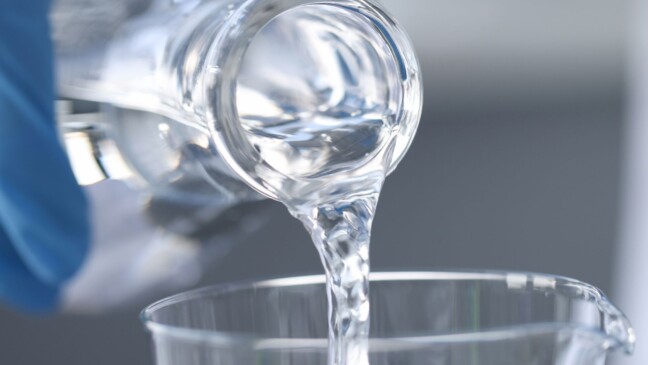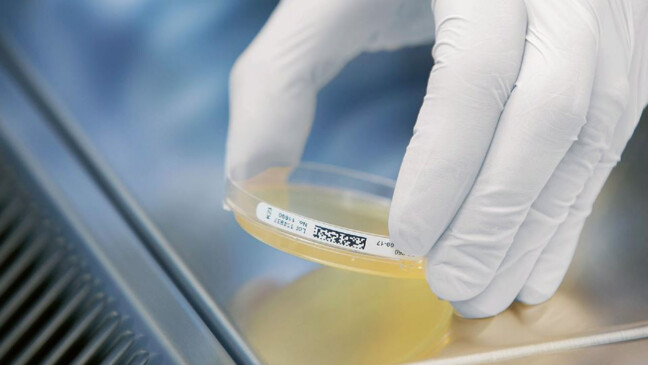
12.06.25
Substance additives in ventilation systems in the healthcare sector
Ensuring hygienically perfect air quality is the top priority in ventilation systems in healthcare facilities. Time and again, however, attempts are made to introduce chemical or biological substances into the air flow, whether for disinfection, odour masking or microbial control. However, such applications must be viewed critically from a hygiene perspective: they harbour risks for patients and staff, are often in conflict with applicable standards and often elude a clear effectiveness test.

Air quality in Switzerland and its significance for the health sector
Air quality in Switzerland has improved significantly over the last few decades thanks to many air pollution control measures. However, the limit values for particulate matter, nitrogen dioxide and ozone are still regularly exceeded, particularly in areas with heavy traffic and during smog periods.
Health effects
Various pollutants in the outside air enter the lungs with every breath. Particulate matter and ozone are among the most relevant substances. Even brief exposure can cause breathing difficulties, irritation and other symptoms. Repeated or chronic exposure increases the risk of cardiovascular disease, chronic bronchitis or asthma. There is also evidence in the literature of a link to increased mortality. Children, older people and people with existing illnesses are particularly affected.
According to the model calculation of the Swiss Tropical and Public Health Institute from 2023, around 2,300 premature deaths per year in Switzerland can be attributed to air pollution.
Impact on the healthcare system
The health consequences of air pollution are a burden on the Swiss healthcare system. Every year, almost 14,000 days are spent in hospital due to air pollution-related illnesses. In addition, there are around 12,000 cases of acute bronchitis in children and around 2,300 new cases of chronic bronchitis in adults.
Healthcare objectives to safeguard air quality
Healthcare facilities have a responsibility for the quality of indoor air. Unlike in residential or office buildings, particularly susceptible people spend time here, including immunocompromised patients, newborns, elderly people or people with chronic respiratory diseases. The hygiene requirements for ventilation and air conditioning systems and air quality are correspondingly high.
The overarching objectives are:
- Prevention of nosocomial infections caused by airborne pathogens, e.g. Aspergillus spp.
- Reduction of chemical-physical pollution caused by VOCs (volatile organic compounds), for example.
- Ensuring a stable microbial room climate through controlled ventilation, especially in operating theatres, intensive care units, isolation rooms and laboratories.
- Contribution to general well-being and recovery through a pleasant indoor climate and clean, odourless air.
These objectives are based on established standards and recommendations such as the SWKI guidelines VA105-01, VA104-01 and VA101-01, the SIA 382/1, the VDI guidelines 6022 and 2047 and the recommendations of KRINKO and the DGKH in Germany.
Adding substances to indoor air: between desire and responsibility
In recent years, there has been an increase in offers and products that promise the targeted release of chemical, biological or “natural” substances into indoor air systems. These range from fragrancing systems and bioactive air purifiers to devices for automated air disinfection with hydrogen peroxide, ozone or essential oils. Suppliers promise an improvement in air quality, a reduction in germs or an increase in well-being. This development is not limited to the air sector: Similar trends can also be seen in the area of water hygiene, for example through the use of silver ions, chlorine/chlorine compounds or supposedly probiotic systems. This gives the impression that hygiene can increasingly be “dosed”.
However, this trend is caught between technical feasibility, commercialised innovation and hygiene responsibility. Particularly in the healthcare sector, where vulnerable groups of people are cared for, such systems must be scientifically valid, toxicologically evaluated and normatively categorised. The following section examines the extent to which this is currently the case.
1. normative and legal bases
The Federal Chemicals Notification Authority has determined that systems for continuous room air disinfection by fogging or gassing with disinfectants such as active chlorine, hydrogen peroxide or ozone are not permitted while people are present. The use of biological agents is not prohibited in principle, but is subject to careful scientific and toxicological evaluation.
Regardless of the type of substance used, the SWKI VA105-01 and SIA 382/1 standards require that ventilation systems are operated in such a way that no health hazards arise for people. The active supply of substances is therefore contrary to the basic requirements for the safe operation of ventilation and air conditioning systems.
There is also comparable restraint internationally. The WHO, the FOPH and expert committees from Austria and Germany emphasise the need for caution when dealing with air additives in sensitive areas such as hospitals.
In addition, there are no valid, reliable studies that would scientifically justify the regular or permanent addition of such substances. Individual manufacturers or suppliers refer to efficacy tests in laboratory situations or empty rooms, but there is a lack of systematic studies that prove the safe operation of such systems under real conditions in health areas. Neither the toxicological safety nor the microbiological target effect are currently comprehensively documented or standardised.
2. state of research and study situation
Studies on the effectiveness of individual airborne substances such as hydrogen peroxide or ozone exist, but almost exclusively in relation to empty rooms, for example for terminal disinfection. There is a lack of reliable data for occupied and therefore busy areas or continuous operation. Fragrancing systems or the use of “probiotic air purification” in particular are not evidence-based and cannot be regarded by experts as reliably effective or harmless. In addition, there are no harmonised test methods that can be used to reliably validate the actual microbiological or chemical effect of such additives.
3. long-term effects and open questions
To date, there is a lack of long-term studies on the effects of chemical or biological air additives in proven areas of the health sector. In particular, there is a lack of toxicological studies:
- Chronic exposure in patients with lung or skin diseases
- chemical reactivity of additives in conjunction with indoor air constituents, for example formation of secondary VOCs
- Changes in microbiological indoor air quality in particularly sensitive areas such as operating theatres, isolation rooms or neonatology units
- potential residues in air ducts, filters, appliances or furniture
In addition, international studies show that fragrances and disinfection by-products in particular can be a relevant source of headaches, mucous membrane irritation and allergic reactions, especially with prolonged or uncontrolled use.
4 Conclusion: No substances in indoor air without clear evidence
Adding chemical or biological substances to indoor air is an uncontrollable intervention with potentially far-reaching consequences. As long as there are no independent, reliable long-term studies on the effect, safety and harmlessness of such measures, especially for risk groups, they should not be added.
A responsible approach to air quality in the healthcare sector does not mean introducing additional substances, but rather operating existing systems hygienically and in compliance with standards.
Air quality is not improved through human intervention, but through controlled, documented and technically mastered system management.
The health of patients and staff must always take precedence over technical or atmospheric effects.
Sources:
- https://www.bafu.admin.ch/bafu/de/home/themen/chemikalien/industriechemikalien-nach-stoff/in-der-luft-stabile-stoffe.html
- https://www.fedlex.admin.ch/eli/cc/2005/478/de
- https://www.who.int/news-room/fact-sheets/detail/ambient-(outdoor)-air-quality-and-health
- SwissTPH2023_Gesundheitsnutzen_AQG_WHO_2021.pdf
- https://www.zh.ch/de/umwelt-tiere/luft-strahlung/luftqualitaet-auswirkungen.html
- https://www.bag.admin.ch/bag/de/home/gesund-leben/umwelt-und-gesundheit/luft-und-gesundheit/innenraumluft.html
- Increased Disinfection Byproducts in the Air Resulting from Intensified Disinfection during the COVID-19 Pandemic | Request PDF
- Occurrence, genotoxicity, and carcinogenicity of regulated and emerging disinfection by-products in drinking water: A review and roadmap for research – ScienceDirect
- https://www.anmeldestelle.admin.ch/chem/de/home/themen/pflicht-hersteller/zulassung-biozidprodukte/schweiz-spezifische-zulassungsbestimmungen/verbot-raumluftdesinfektion.html?utm_source=chatgpt.com
- Schweizerischer Verein von Gebäudetechnik-Ingenieuren (SWKI). SWKI VA105-01: Raumlufttechnik in Gesundheitsbauten – Planung, Realisierung, Betrieb und Instandhaltung. Ausgabe 2022.
- Schweizerischer Ingenieur- und Architektenverein (SIA). SIA 382/1: Lüftungs- und Klimaanlagen – Allgemeine Grundlagen und Anforderungen. Ausgabe 2023.
- Verein Deutscher Ingenieure (VDI). VDI 6022 Blatt 1: Hygieneanforderungen an Raumlufttechnische Anlagen und Geräte. Ausgabe 2018.

